
Intimidation in Housing
|
| 1943 Data | ||||
| Belfast | ||||
| Glasgow | ||||
| Birmingham | ||||
| Sheffield |
Hons Arts Thesis, QUB, Department of Geography, 1959.)
Faced by this state of affairs, the committee of the Northern
Ireland Housing Trust decided to embark upon a programme of construction
of large suburban housing estates. These would be built in peripheral
locations ringing Belfast (see diagram) and other urban areas
of the province. One of the largest of these was the Rathcoole
Estate
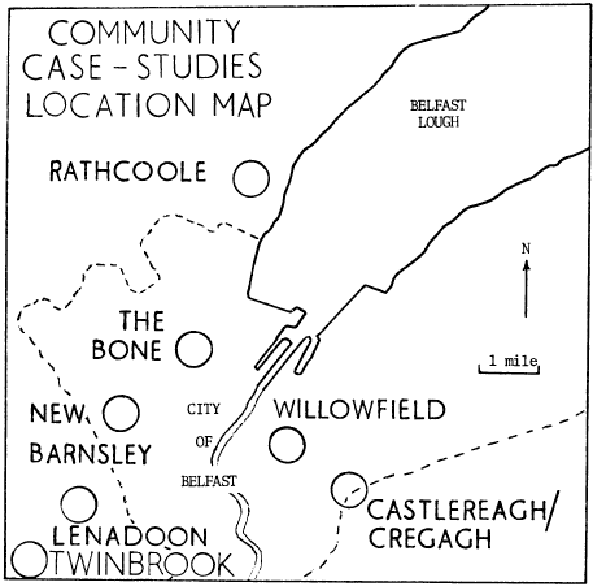
Rathcoole
In 1952 construction began on a site of 366 acres on the lower S.E. slopes of Carnmoney Hill (763') in the townland of Whitehouse, 6 miles north of Belfast.
Approximately 3,800 dwellings with a population of 10,000 was projected for a "self-contained neighbourhood". Rathcoole was to become the largest housing estate in Northern Ireland, and was incorporated as part of Newtownabbey when the latter received urban status in April 1968. "The primary objective of the planners was to create a balanced neighbourhood within a new urban community." (MA Neill) [1].
However a number of problems began to afflict the growing population of Rathcoole. Early residents in the first phases of building on such a large estate can expect inconveniences and a lack of community services and facilities. But a recent detailed study of social amenities in Rathcoole indicates that provision lagged chronically behind population influx into the Estate. Even today there is not a single pub on an Estate of 10,000 people. Not a single community centre was built for a decade between 1958-68. Some community leaders in this estate have little hesitation in pointing to lack of community facilities as a basic reason for unrest and instability in Rathcoole[2].
The very size of the estate caused problems. "In an estate of 10,000 people, the neighbourly feeling of an intimate community is easily lost. To counter this danger houses have as far as possible been so grouped that each locality may feel an individuality of its own while yet belonging to the larger entity". (M A Neill op. cit.)
The Rathcoole/Newtownabbey community also suffered from limitations imposed by geographical location. Attempts to build up local industry, local retail and service facilities, and entertainment and cultural activities, suffered because of the proximity of more comprehensive alternatives already existing in Belfast[3]. Rathcoole people, whilst feeling apart from Belfast nevertheless could never be independent of it.
Both M B Padden (op. cit.) and E J Crilly emphasise these ties with Belfast. Implicit in Crilly's analysis was the relationship between areas of origin and breakdown of religious composition of the new estate. Clearly Rathcoole was a genuine attempt to create a balanced community from the point of view of religious mixings[4]. For a decade and a half it seemed as if success had been achieved.
"In 1969, when violence hit Derry, Belfast and other places, Newtownabbey was totally free of any disturbance. However it was judged necessary by a meeting of about 200 local citizens and clergy (all denominations represented) to set up a Peace Committee to ensure that such trouble didn't spread here."[5]The peace committee formed local "vigilante" groups to protect all the residents of the estate from any outbreak of hooliganism or violence. This measure was successful. However, by mid 1971 the Provisional IRA bombing campaign was underway. Local incidents of violence were on the increase and tension was rising. Following this the "Rathcoole Defence Association" (RDA) was created (mid 1971), excluding Catholic offers of participation. It was a blatantly sectarian organisation which set up barricades at entrances of the estate and assumed the duties of policing Rathcoole. The "Tartan" gang and teenage hooligan elements began to congregate at these barricades; belligerence towards Catholics was indicated by an increase in beatings, and threats directed against the minority group. When the barricades were removed groups of "loyalist" vigilante foot patrols continued on the Estate.
Intimidation against Catholic families in Rathcoole was almost an everyday occurrence following the disturbances which resulted from the reintroduction of internment in August 1971. The situation continued to deteriorate as regards protection of Catholic families living in Rathcoole, so that in February 1972 an anti-intimidation committee comprising both religious groups was set up to combat the threats and violence and help the victims of intimidation. There was an absence of protection by the Police or by the Army during the months approaching the week of The Twelth. Threats, fear or violence were being experienced by most Catholic families in the Rathcoole and Monkstown estates. The RDA had virtually taken over control of these Estates and a collapse of communal order was evident.
Barricades had again been erected in June 1972 and for 3 days entrance to the Estate was barred to all vehicles except those approved at the barricades. Because of scarcity of police, intimidation continued unchecked and flight of Catholic families from Rathcoole and Monkstown had become commonplace, with squatting being organised for incoming Protestant families by members of the DA. The NI Housing Executive office in Newtownabbey no longer had full control over housing allocation in the estates.
In the period between the introduction of Direct Rule (March 1972) and mid-August, 75 families have been confirmed as victims of intimidation from homes in Rathcoole. A random sample of these intimidated families were examined in detail. School attendance figures[6] confirm that a similar story applies to the Monkstown Estate, where only a handful of Catholic families remain. In Monkstown estate there has been continuous intimidation since the advent of internment. There have been some periods of intense intimidation (ie, in the weeks preceding 12 July); but generally a process of gradual evacuation of families between September 1971 and September 1972 has occurred as indicated by declining school enrolment figures. Though the situation is now more static and stable, there is still fear that "the remaining handful of Catholic families will be forced to leave in the next crisis."[7]
The neighbouring Greenisland public housing estate remains a good example of an integrated estate. However a spate of intimidation of Catholic families caused approximately 10 stricken families to move out during the 3 months preceding September 1972. During the summer 10 - 15 Catholic families had received, anonymously, Mass cards in the post[8]; but in mid-September Tartan gangs attempted open violence and destruction on 3 consecutive nights.[9]
According to the local St Vincent de Paul Society, it is the poorer families with an average of 4 children per family, who seem to be on the move from Greenisland at the present time[10]. Because "The Bone" and Andersonstown districts in Belfast (together with Derry[11] are the chief reception areas for these poorer families, pressure will inevitably be placed on the social services and schools in "The Bone" and West Belfast. Meanwhile certain school teacher redundancy is anticipated at Greenisland[12], and local welfare agencies are unlikely to be unduly taxed[13]. This serves to underline the need to monitor social indicators and the need for ongoing research into situations which can change rapidly over a short period of time, so that resourses can be channeled as required.
A steady stream of threats, and damage to property, has caused an exodus of about one Catholic family per week from the Greenisland Estate. This is reflected in enrolment figures for a local primary school. Only a strong Tenants' Association and other non-sectarian community groups, together with decisive response to the Tartan menace by Carrickfergus Police, has prevented further deterioration of the situation. Local community leaders would not hesitate to call for Army presence should the situation get beyond the resources of the RUC.
One can surmise that the major crisis in Rathcoole would not have occurred if similar action had been taken against barricade builders and Tartans in the incipient stages of gang activity in that community in 1971 and 1972.
By July the situation in Rathcoole had deteriorated to such an extent that only pressure of publicity[14] and a confidential Report to the Administration[15], caused firmer measures to be taken. But the strengthening of the Army presence and directives to the RUC at Whiteabbey and York Road, were too late for a minimum total of 75 confirmed family victims of intimidation in Rathcoole between March and August 1972. The evidence would indicate that many more families moved from Rathcoole without contacting any statutory or voluntary agencies.
Mid-September 1972 estimates place the number of families squatting in Housing Executive property in Rathcoole and Monkstown at between 200- 250 families[16]. In the year following Direct Rule the Housing Executive has been unable to control housing allocation lost during the absence of civic order in Rathcoole. Housing allocation in Rathcoole, for the most part remains in the hands of the RDA, and evidence exists that intimidation continues in the Rathcoole Estate in 1973[17].
Observations
1. The deterioration of the situation in Rathcoole in Mid 1972 was predicted by certain community leaders, and was reported to the Police and the Army. If strong Police and Army presence had been evident in June 1972 in anticipation of the "Twelth celebrations" then the spate of intimidation might have been successfully contained. After mob violence, destruction and hooliganism had actually broken out in Rathcoole, early and decisive action by Police and Army might still have stabilised matters. Lack of authority escalated the fear and violence which drove people from their homes.
2. Insufficient manpower. The Police were, and remain, too thin on the ground to be effective in a situation similar to that which prevailed in Rathcoole during Mid 1972. They cannot be blamed for sitting out the storms in the Police barracks. Family case studies and Agency interviews have brought to light a reluctance on the part of Whiteabbey and York Road RUC to confirm that intimidation of families had in fact occurred. In addition certain case studies indicate that the Police have been ineffectual in helping and comforting intimidated families.
Why then, prior to the recent willingness (since September 1972) of the local Police to confirm cases of intimidation[18] (which in the past was required by the Housing Executive for intimidated families to get on the Emergency Housing List), was there a reluctance on the part of the local Police to recognise fully that intimidation was taking place in Rathcoole?
Was it due to:-
3. Since Mid 1972 the local office of the NI Housing Executive has been unable to perform its function with the degree of urgency and sympathy warranted by the situation. Lack of directive on the question of squatting had aided RDA housing allocation activities.
a. Genuine mistakes or forgetfulness in reporting and dealing with cases of intimidation? b. Confusion on the part of the police in interpreting what does or does not constitute intimidation? c. Fear for personal safety? d. An unwillingness to confirm that intimidation had taken place when there was ample evidence that it was rampant. RUC failure to recognise the intimidation problem when more than 50 families had been forced to leave their homes and when a number of agencies had contacted the station to complain about inaction?
The Bone
A Community Development worker in the area provided us with a succinct definition of The Bone, which is a mixed area located between Alliance Avenue and the Clifton and Crumlin Roads.
It is very sensitive in terms of tribal strategy. The Bone area is a well defined district in a state of flux at present, with impending changes in the religious territories. Especially volatile areas include the Heathfield Road, Torrens Road/Torrens Crescent area, and the Alliance Avenue neighbourhood. Here intimidation is rampant and ongoing [19].It is bisected by the Oldpark Road, and is notorious for the large number of sectarian murders which took place there. Its circumference contains some private housing and converted Victorian houses, but The Bone is uncompromisingly working class, with some of the smallest and oldest houses in the city. The southern part of the area and the parts east of the Oldpark Road are Protestant, while a strong Catholic enclave crowds around the Sacred Heart Church. The dynamic changes in the borderline between the two religions makes The Bone one of the cockpits of Belfast, not surprising perhaps with Catholic Ardoyne and Protestant Shankill its immediate neighbours to the north-west and south-west.
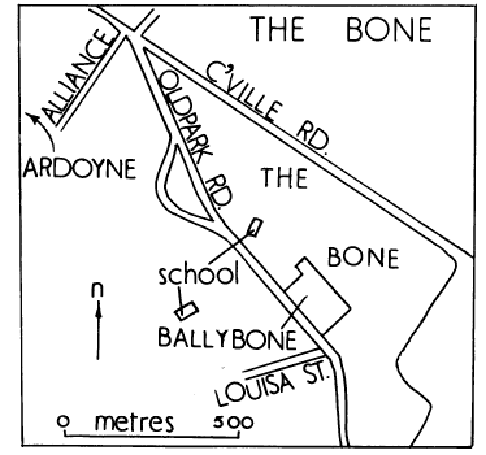
The Bone was scarcely affected by the population movements of August 1969. Certainly some people left their homes, many of them into the Ballysillan estates in the north-western suburbs, but there is no way of telling how large the number was or whether any large scale intimidation took place. However the people who did move, both Catholic and Protestant, included the better-off and better educated people in the area - a 'creaming-off' of those who anticipated future trouble in The Bone. So despite the small numbers involved, the effects of 1969 were significant. The employment rate in the area from 1970 to 1972 shows that an average of more than 20% of the men were jobless. Among those who are employed there are no professional or skilled workers. Men employed as bus drivers and conductors represent the better-off people in the area[20].
During the next two years the area remained relatively stable. But the introduction of internment in August 1971 and the subsequent unrest in Belfast had dramatic effects on the area. In that month alone at least 140 families evacuated the area; at least 61 moved in. In addition a "redistribution of Catholic and Protestant households"[21] took place within the area. There were cases of families exchanging their houses on different sides of the street.
The effects of these movements on The Bone were important. Stray Protestants in predominantly Catholic streets moved out of the district and other Protestants alarmed by the escalation of violence in the area followed them. To the North, the Ballysillan estates and the Westland Road area were popular venues for these Protestants[22]. The Catholic movements, here as in almost every part of Belfast, were markedly different. The stray Catholic families in predominantly Protestant areas moved but mainly into the Catholic Bone or other Catholic enclaves.[23]
Furthermore many of the Catholics who had left the Ballysillan
estates, and whose houses were inherited by the Protestants who
had evacuated the Protestant Bone, began to return to the Catholic
Bone. The result was that the Catholic Bone became seriously overcrowded
and the Protestant Bone contained many empty houses. In a matter
of weeks the Catholic ghetto spread across the Oldpark Road for
the first time into the area known as the Ballybone.
| Destination | ||
| Area predominantly of same religion | ||
| Mixed-religious area in Northern Ireland | ||
| Over seas |
Autumn and winter 1971/1972 saw further fluctuations in the population of The Bone. Protestants began to leave the area around the Ballybone; Catholics evacuated the northern part of the area, Torrens - Heathfield. Increasingly the movements were accelerated by threats and intimidation, apparently from both sides. During June 1972, for example, the Oldpark police station received 39 reported movements resulting from intimidation. Twenty of these were Catholic, 17 Protestant, and the religion of the other two is not known[25].
The changes in the area are particularly reflected in its primary schools. The populations of Finiston Primary School (Protestant) and St Columban's (Catholic) both declined by 20% and 9% respectively in the school year 1971-1972 alone. Apart from the slight overall decline in the area's total population, the new families entering the area tend to be older -at the moment The Bone is hardly attractive to families with small children. The schools have had their share of trouble. St Columban's is a frequent scene for gunbattles; Finiston school has been an army post for some time. Both buildings are riddled with bullets, and both teachers and children worked at times in conditions of real fear and danger.
Teachers in both schools observed that it was commonplace for children to be involved in riots, that play had become more violent and disciplinary problems increased. Teachers in both schools remarked on the definite decline of general and academic standards. For some time parents have tended to withdraw their children from the schools and send to schools outside the district. All of which is hardly conducive to good education, despite dedicated and able staffs in both schools.
The position in 1972 was that the Oldpark area has become one of the most violent in the city. The Catholic and Protestant parts of the area have virtually been cleared of religious minorities, but the middle part of the Oldpark Road is still in a state of flux. It is not particularly daring to prognosticate that the area will change further in the future. But the changes have been more fundamental than the redrawing of demographic boundaries. The entire fabric of the area has been affected. The prosperity of the area has declined; the facilities have deteriorated as many of the services withdrew to neighbouring streets; the age structure of the population has gradually but definitely altered; the welfare needs of the people are radically different to what they were in 1969. In some ways The Bone of pre 1969 simply no longer exists.
New Barnsley
New Barnsley is a small post-war estate built on the Western outskirts of Belfast. Physically it is compactly enclosed by the Springfield Road and the Black Mountain: demographically it was 94% Protestant in 1964. Facing it across the Springfield Road is Ballymurphy, also post-war, but 96% Catholic.
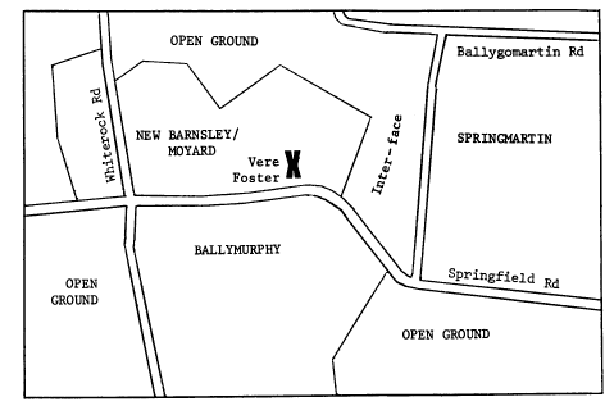
Between 1964 and 1969 the percentage of Protestants in the New Barnsley estate diminished from 94% to around 60%[26]. This decline was gradual and partly due to minor dissatisfaction about the estate over matters like unsatisfactory heating and the high transport costs into the city centre. But there is no doubt that an important reason for the Protestant withdrawal was New Barnsley's position at the north end of the great Catholic enclave of the Falls, an enclave which had been gradually expanding during the 1960s.
The aftermath of the events of August 1969 particularly affected the parts of the city which felt isolated, and New Barnsley might have been expected to experience unrest. That it did not was largely due to an organisation called the Springfield Joint Committee. This Committee was formed to prevent the entire Upper Springfield area from breaking up, and comprised representatives from Turf Lodge, Springfield, Highfield, Springmartin, Moyard, New Barnsley and Ballymurphy - all the estates in the area. The committee - which controlled 1,000 men, both Protestant and Catholic - supervised the patrolling of the area and helped to keep it stable between August 1969 and April 1970[27].
When trouble eventually did break out, it came suddenly. It also came, perhaps significantly, on a holiday - Easter Tuesday 1970 - when many of the organisers of the Joint Committee were out of the town. It was not untypical that a procession and the reaction against it was the occasion for the trouble. The local Orange Grand Master lived in New Barnsley and the procession started from his house down the Springfield Road. In the riot which broke out during the procession stones were thrown into the New Barnsley estate and a number of windows were broken.
This was followed by a highly organised evacuation of some of the Protestant families from the estate, mainly to Glencairn and Shankill. This evacuation, and the panic which provoked it, appears to have been organised by known political leaders from outside the area, with lorries and other facilities provided. Until their arrival, the residents of New Barnsley showed no signs of panic. When there was no follow-up of the Easter Tuesday violence most of them returned to their homes. Nevertheless many of the New Barnsley inhabitants began to ask the Housing Trust for moves to other estates. There were some rumours of direct intimidation taking place at this time, but we were unable to find evidence that this was so.
The events which converted this trickle into a torrent took place on June 12. Again the occasion was an Orange procession and the reaction to it from Ballymurphy, [28] and again a major organisational part was played by politicians. The causes of the riot are not our concern, but the effects were immediate. The army intervened between the two sides, but the riot continued spasmodically against them for a number of days. There is no doubt that it was accompanied by both direct and indirect intimidation within the estate. The effect was dramatic. Within two months the 700 Protestants in the estates had all left - a complete evacuation. In October the Presbyterian minister vacated his house, which was ironically on the Ballymurphy side of the Springfield Road. He had no flock; his church hall, the now famous Henry Taggart Memorial Hall, became an army post.
There are now 13 Protestant families in Ballymurphy, mostly old age pensioners - there are only three minority families living in New Barnsley.[29]
When a community can be categorised as almost 100% homogeneous in its religious affiliation then no religious minority group from the "other side" exists within that community. How then can intimidation of people from their homes occur in such a residential environment? A three-fold answer can be given -
Firstly: families are caught in a vulnerable position where their houses are in direct line of fire between gunmen from both sides of the sectarian divide. From the higher ground to the East, the overwhelmingly Protestant community of Springmartin overlooks the overwhelmingly Catholic communities of New Barnsley and Ballymurphy. The main access to all these communities, the Springfield Road, has become dangerous to travellers, and at times has been a free-fire zone separating the Provisional IRA, the UVF/UDA, and the British Army. All the dwellings once inhabited along this section of the Springfield Road and the flats and houses bordering the intervening waste ground have been abandoned. (See diagram.) This is intimidation of families resulting from localised urban guerilla warfare. Empty blocks of flats, smashed windows and walls pock-marked by hundreds of bullets testify to this. This is not unique in Belfast - it is still a fact of life to the retreating Protestant and Catholic families in the Suffolk district.
Secondly: families who have been subjected to the harassment and intimidation resulting from the presence of military factions, like the Provisional IRA, UVF, UDA, in their community. Case studies of this type of paramilitary intimidation of families has come to our attention from New Barnsley and Ballymurphy. It is applicable to Catholic families with UDR, RUC or British Army connections, past or present. The evidence is that it does not appear to exist to any great extent in the New Barnsley community case study. On the other side of the coin, Protestant families living in wholly or predominantly Protestant districts, and who might have "disloyal" connections, often receive little mercy at the hands of Protestant extremist intimidators.
Thirdly: families who have taken the brunt of attention from the presence of the British Army. As one of the havens for Provisional IRA urban guerilla warfare the Catholic communities of New Barnsley/Moyard have been a focus of occupation by the British Army. Following "Operation Motorman" in New Barnsley[32] the Parachute Regiment reoccupied the Vere Foster School/Henry Taggart Hall complex as a base for rooting out members of the Provisional IRA. The consequences of this in the New Barnsley estate have been considerable. The effect of army activities directed against individuals and families [33] in the street and in their homes has resulted in a number of families[34] and individuals [35] feeling obliged to leave the district. The pressure of the community and the deterioration of the environment have created conditions from which residents would like to escape and which deters new families from replacing them [36]. Public opinion outside parts of West Belfast has been little aware of repressive conditions in these areas.
Our investigations in the New Barnsley area persuaded us that questions should be posed as to the advisability of using specially trained assault infantry in situations which bring them into everyday contact with the general public. One community worker told us:- "I am sure that the negative aspects of the aggressive military campaign are being disastrous. under the continual experience of apparently arbitrary harassment in home and street, family and community life is breaking down completely, and a depressing atmosphere of total despair hangs more and more heavily over the area. Constructive community work is essential, so that in the long term there may be a meaningful dialogue on real issues across the sectarian divide, but any development of this kind is being effectively crippled by current attitudes and actions of some members of the security forces."
Lenadoon and Twinbrook
Lenadoon and Twinbrook are two of Northern Ireland's most modern suburban estates. Lenadoon was completed in 1970 and the first tenants entered Twinbrook in 1971. Both are owned by the Northern Ireland Housing Executive and both started off with both Protestant and Catholic tenants. The other common factor is their position to the west of the city, where the expansion of the predominantly Catholic part of the city has reached both these areas.
The events of Sunday, July 9th, 1972 when the short-lived IRA
truce was broken made Lenadoon a catch phrase throughout the world.
The reasons for the conflict that day however stretch back at
least to the events of August 1969, as do so many of the other
crises of the last 3 years. The housing movements which followed
the invasion of the Lower Falls that summer were extremely heavy
- probably in excess of 4,000 families [37]. Many of
these families had lost their homes and possessions and were in
great distress. Hundreds were temporarily housed in Catholic schools
or prefabricated buildings. These families were allowed by the
Housing Trust to occupy completed or nearly completed houses in
Lenadoon estate, which was still under construction at the time.
This decision arose directly from the emergency situation.
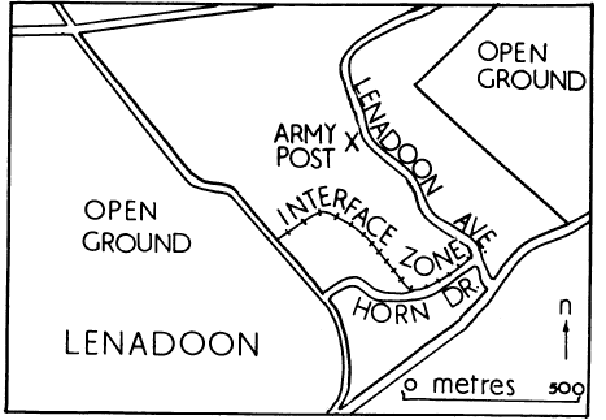
Previous to that date Lenadoon had been a mixed-religion estate. Catholics were in fact a minority. A survey in 1970 found that 45% of the Roman Catholic families in the estate came from the Falls Road area, and 48% of the Protestants from the Shankill and Donegall Road districts of Belfast. The layout of the estate did not encourage the mixture of these groups. "Amenities and public services are all peripheral and tend to draw the inhabitants to the extremities of the estate rather than to a central focus. The physical layout in itself seems to discourage the formulation of an integrated community".[38] The injection of a large bloc of Catholic tenants in the northern part of the estate alarmed the Protestants - many of them believe that, even despite the immediacy of the problem, the Housing Trust should have been more careful about jeopardising the future balance of the estate "external influences were created by a rapid growth of a new housing area and the subsequent introduction of a new element into a relatively stable society. This mass movement was the end result of a chain of events initiated by the large-scale redevelopment of one section of inner Belfast and the riots of 1969-70 If the new group had been introduced gradually then assimilation might have occurred; mass migration made this impossible... In this way segregation is perpetuated over in planned communities"[39]. There was a slow but definite drift of Protestants away from the Glen Road side of the estate towards the Stewartstown Road side (see map). They were quickly replaced by Catholic tenants.
It would be a mistake to regard this changeover as dramatic, or to assume that direct intimidation was rampant. It represented a tendency rather than a change, and the estate was relatively peaceful between late 1969 and early 1971. But with internment and its aftermath, radical changes began to happen.
In the month of August 1971 alone more than 100 families left their houses, the majority of them Protestants from the Falcarragh Drive part of the estate. The building of an army post at the corner of Falcarragh Drive and Lenadoon Avenue and the frequent gun battles which followed between the Provisional IRA and the army created considerable stress on the entire estate. Children were unable to play in safety: the emotional strain was considerable: overshots from the gun battles hit houses and broke windows. There was virtually no direct intimidation but the situation continued all over winter and spring 1971/72. During this period Protestant families left the estate in increasing numbers and the middle part of Lenadoon Avenue - between Falcarragh Drive and Mizzen Gardens - became predominantly Catholic. For the first time there was a gradual evacuation of Protestant families from parts of Horn Drive. An army report relating to this period 1971-early 1972 concluded:- -"Finally a peace line was established in 1971 across Lenadoon Avenue on the line of Falcarragh Drive. The Housing Authorities tried from then on to allocate houses south of this line to Protestants and north of the line to Roman Catholics."[40]
The next and most notorious episode in the story of Lenadoon followed a marked increase in intimidation in many parts of Belfast during Spring 1972. This backcloth of violence, exacerbated by the erection of UDA barricades in May and June, produced another flight of Catholics into what were regarded as safer areas. Some of these evacuees moved into the houses of relatives in Upper Lenadoon. They asked the Housing Executive for keys and rent books for the vacated houses in Horn Drive, and these were promised to them.
It was at this point that Lenadoon became the focal point of a political power struggle between the UDA and IRA. The former were determined to keep lower Lenadoon Protestant, the latter to extend Catholic territory further down the estate. As the struggle intensified the interests of the people in the houses were forgotten as high politics and strategic considerations took over. The final confrontation, at Mizzen Gardens, resulted in the resumption of hostilities after the IRA truce. It also resulted in a clear definition of the lines between Catholics and Protestants. The mixed area in the middle of the Avenue had disappeared.
Twinbrook, about two miles further out the road, has had its share of publicity too, but for different reasons. It was conceived deliberately as an experimental mixed-religious estate and certainly the first 700 of its planned 3,000 families included a very high proportion of people who were weary of sectarian stresses in Belfast. These first arrivals formed a strong Tenants Association, which was determined to keep the area steady. The fact that rents were relatively high made their task easier. Their main problem was that Twinbrook was often regarded as falling within the probable expansion of Belfast's Catholic areas. It became more difficult for the Housing Trust (now the Housing Executive) to attract Protestants and the magic 50-50 figure slowly began to slip[41].
The greatest challenge to the integrated character of the estate came in June 1972. Following the erection of the UDA barricades at that time, about 50 evacuees from all over Belfast, all of them Catholics and mostly from Rathcoole estate, began to squat in Twinbrook, occupying houses which had just been built or were nearing completion. The ratio of Catholics to Protestants tipped to 3 : 1 [42].
Twinbrook Tenants" Association moved quickly and a Community Relations Committee was established. An anti-rumour service was set up; new tenants were met upon arrival and meetings took place with the Housing Executive. However the problem was clearly the reluctance of Protestants to come to Twinbrook, and the desire of some Protestants inside the estate to leave it.
Security was only part of the trouble. The question of schooling is beginning to loom large. A Catholic school is almost completed, but a school for the Protestant children will not open until late 1973. Protestants feel that plans are being delayed until it becomes clear whether or not there will be any Protestants left in the estate to attend it.
Another sore point for Protestants is the bus service. The main route from Twinbrook to the centre of Belfast runs down the Falls Road, thus, the Protestants claim, further strengthening the image of Twinbrook as falling within the Catholic part of the city.
Despite all this, there are indications that the strong Tenants' Association has managed to calm matters down in Twinbrook, at least temporarily. The absence of such an organisation in Lenadoon may ultimately be seen as a significant factor in the history of that estate.
Unlike Lenadoon, Twinbrook has had no gunfire, no bombs, no intimidation. But Protestants in the two estates share a common fear about religious territorial trends. The experience of Twinbrook points out two important lessons. The first is the importance of a strong community- based Tenants Association: and the second is the dangerous consequences of allowing uncontrolled squatting in public housing estates.
Castlereagh and Cregagh
Castlereagh and Cregagh are two large estates in East Belfast, just outside the city boundary. They are both under the jurisdiction of the Housing Executive. Largely Protestant, the proportion of Catholic families was 10% - 15% in Cregagh and 25% in Castlereagh[43].
Although most of East Belfast is predominantly Protestant, considerable Catholic minorities lived in comparative peace in both Cregagh and Castlereagh until 1971. Internment and the housing movement which followed it was really the first serious irritant in what had been a stable society. They produced among Protestants a distrust of the Catholic minority in their midst, and a need for housing for co-religionists forced to flee from other parts of the city. Catholic families began to feel a good deal less secure, and harassment steadily increased in both estates.
Tartan gangs appear to have played a major role in this respect. There were threats and occasional attacks on Catholic youths in the Cregagh estate; warning notes sent by post, windows broken and other types of general provocation. The first families began to leave. Approximately 100 minority families fled Cregagh between August 1971 and January 1973. (44) The emergence of the Ulster Defence Association in Cregagh posed a more serious threat in June 1972.
During late 1971 in Cregagh a mixed-religion vigilante group had patrolled the area, supported by the Cregagh Tenants Association. Cregagh estate was built in 1946-47. About 120 of the l,l00-l,200 families in the estate were Catholic. During the 6 months between April and September 1972 40%-45% of the Catholics in the estate abandoned their houses, many of them moving to west Belfast, and some squatting in Twinbrook[45]. By January 1972 the vigilante group had ceased to operate. In June however a group claiming to be UDA resumed patrols and established barricades. Barricades were erected, marches took place through the estate, and an atmosphere was created which frightened many Catholics from the estate. The destruction of the Rosetta bar in early July was seen as a more direct threat to them, and a number of other families moved.
There are considerable differences of opinion among residents of the estate in assessing the role of the UDA. Many Protestants here and in other East Belfast estates believe that the UDA is a stabilising force and in fact reduces the extent of intimidation. This was not our conclusion. Certainly some Catholic families perceived threats which did not exist. On the other hand many Catholics felt that the mere existence of the UDA in the area, their patrolling the streets, manning barricades, stopping and examining people, was in itself intimidatory. This fear is substantiated by the fact that the army and police warn clergymen and community leaders of the minority group to seek protection of the Security Forces if they venture into Cregagh and Castlereagh after dark, admitting that the policing of these areas remained in the hands of the UDA. The police have also acknowledged the control of the UDA over local housing allocation in late 1972[46]. There can be no doubt that Tartan gangs have been the main 'organised' group encouraging intimidation. In Cregagh Tartans are recognised as the junior UDA. The UDA claim that they control the Tartans means either that they are allowing these groups freedom to intimidate on a Sectarian basis, or cannot control the gangs. They cannot claim both to control the gangs and to oppose intimidation [47].
The most common grievance voiced by people in both estates who
want to stamp out intimidation is that of inadequate policing.
There are no regular patrols in either estate, and there was general
feeling in the estate that investigations of intimidation cases
are carried out with less than enthusiasm. The growth of intimidation
in the area seems to have taken place almost casually, and groups
like the Cregagh Tenants' Association feel that it was not sufficiently
backed by effective law enforcement in its attempts to halt the
spread of fear in their area. In particular there appears to be
a strong case for the regular patrols in these estates and the
appointment of at least one Community Relations Policeman in each
station. At present there are two covering all East Belfast. We
were satisfied that the main problem was shortage of policemen
rather than lack of Police commitment [48] in Cregagh.
But even if there is an increase in Police strength in an estate
such as Cregagh, sufficient Army backing is also required to lend
strength to the rule of law. Without such guarantees there is
little likelihood that strong nonsectarian community groups can
be built up to provide stability from the grass roots. In early
1973 there has been an attempt by Cregagh Good Neighbours[49]
to escape the sectarian nightmare which has troubled the community
during the last year. The degree of its success will be an indicator
of the future facing the community.
Willowfield
Willowfield is a good example of the difficulties of definition of the term "community". There can be no doubt that it exists in the minds of the citizens of East Belfast, who will direct the traveller to the RUC station or St Anthony's Church on the Woodstock Road (see map). The bus operator will let you off at precisely that place - "Willowfield".
St Anthony's church, presbytery, schools and convent are to be
found cheek-by-jowl with the Police barracks. These buildings
provide the key to understanding Willowfield as a community divided.
To many 'Loyalists' of East Belfast the presence of the
St Anthony's Roman Catholic complex is an alien presence. St Anthony's
was opened in 1938 under police guard to deter protestors.
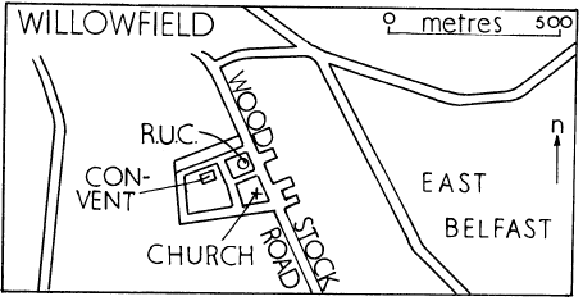
Prior to the construction of St Anthony's church the minority congregation east of the River Lagan had attended mass at St Matthew's on the Newtownards Road. Almost the whole parish had fled following the Belfast riots of 1920-22. But by 1924 St Anthony's parish began to grow again, so that by the early 1930's the minority population in East Belfast had exceeded that of a decade earlier. The mass house was opened in Willowfield in 1931. By 1936 the foundation stone of the church had been laid. A nucleus of about 40 families came to live in close proximity to the church and school, along Willowfield Crescent, Willowfield Parade and Willowfield Avenue. By the late 1960's the Parish boundaries contained a population affiliated to St Anthony's of approximately 3,000 persons scattered throughout the area.
Despite the opposition of many "loyalists" in
East Belfast St Anthony's parish prospered up to the end of the
1960's. During the last 3 years however the Catholic community
of Willowfield has been virtually under a state of siege. The
events of 1969 had hardly affected the co-existence of the two
religious groups in East Belfast. But in June 1970 a major gunbattle
erupted on the Newtownards Road following an attack on St Matthew's
Church. Intimidation of families from "both sides"
was pervasive. Then in the weeks preceding and following the
Twelth celebrations 1970, minority families in East Belfast came
under great pressure. Sporadic intimidation continued until the
introduction of internment, August 1971. East Belfast boiled over.
Catholic schools and churches were petrol bombed. The last of
20 minority-owned shops and business premises located in the Willowfield
district was burned out in Mid-October 1972. Thus intimidation
of minority families has been rampant over the last two years,
as revealed by St Anthony's parish records[50], and
by examination of school enrolment figures[51]. Both
parish population and school enrolment has been reduced by half
since August 1970.
ishioners and families | 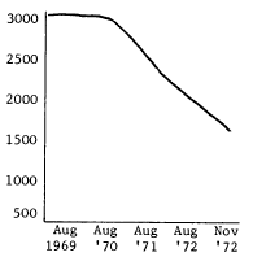 |
| Date | religion in East Belfast | minority religion in East Belfast |
| Aug 1969 | ||
| Aug 1970 | ||
| Aug 1971 | ||
| [Jan 1972 | ||
| Aug 1972 | ||
| [Nov 1972 |
Further verification of the extent and escalation of intimidation
of families of the minority religion in East Belfast, couples
of 'mixed marriages,, and people branded as 'fenian
lovers' [52] in East Belfast is provided
by RUC records. The Willowfield Police district embraces an area
roughly corresponding to the Parish boundaries. Police lists of
reported cases of intimidation indicate that 1972 witnessed a
dimension twice as damaging as that in 1971; an accompanying increase
in the viciousness of the intimidation ploys is also evident
[53].
1971 and 1972 - yearly totals
| Number of reported cases of intimidation | 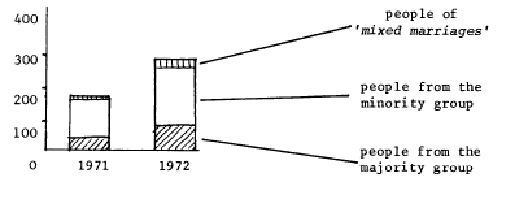 |
month breakdown 1972 |
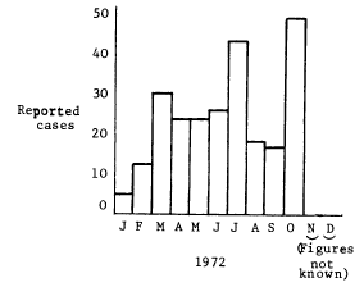 |
Jan 1st - Oct 31st 1972 |
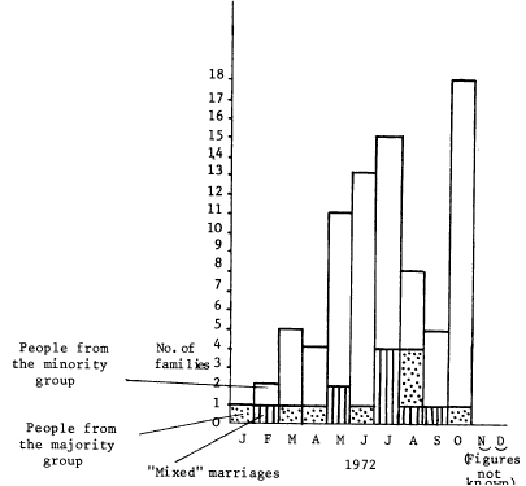
|
However the minority group has suffered excessively from Tartan gangs in Willowfield; and the indications are that in East Belfast in general the "alliance between the young Newtons of the Lower Newtownards Road and Woodstock Tartans has provided a dangerous situation where both Catholics and Protestants live in fear of their activities"[54]. As in the case of the Castlereagh/Cregagh situation, the facts indicate a basic inconsistency in UDA claims to exert control over the Tartan gangs and at the same time to oppose sectarian intimidation.
AND REPORTED NO. OF FAMILIES MOVING FROM DISTRICT
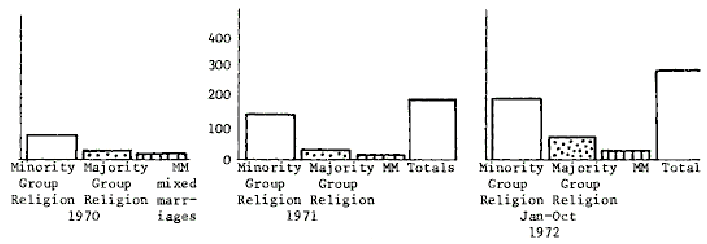
The total number of families reported to the Police at Willowfield as being forced to leave the district between January and November 1972 stands at 80 families. This figure compared with a decrease of 154 families which Willowfield Parish records reveal for the same period.
Again this latter figure represents only those families reported to, or which have come to the attention of, the local clergy. Many families move away very suddenly without reporting this to anyone, or have no desire to report their case if the authorities or agencies are perceived as being non- responsive or repressive. So these refugee figures should be regarded as minimal. (No effort is made to surmise the maximum).
Army and Police attempts to combat intimidation of people because of family religion in Willowfield must be placed in the perspective of a deployment problem.
Firstly law enforcement agencies are faced with the task of protecting threatened families living in locations scattered throughout the Parish. It would require many more thousands of RUC and Army personnel to provide adequate security for each of these individual families. Clearly this is an impossible task in the present circumstances. The most that can be expected is that emergency help to save life and property is forthcoming for intimidated families under attack. Secondly there is the need to protect the nucleus of 34 threatened families grouped in the streets around St Anthony's church and convent. This is a demanding task but by no means an insurmountable one, even given the shortage of security personnel available for duty.
Presently, security arrangements consist of mobile army patrols (no armoured vehicles) which are not much of a deterrent ... "because the routes are known and as soon as they go round the corner the worst damage and destruction by mobs can be done in 2 or 3 minutes"[55].
The series of street riots in the Willowfield District in Mid-October 1972 might have been contained if Army command at Short Strand had taken action on the numerous prior warnings that violence and destruction was imminent in the locality. The doubling of mobile patrols strength from 10-20 soldiers was too late to prevent a siege of Willowfield Police Barracks, invasion and damage to the Catholic church, burned out business premises, and the flight of a further 18 families in the space of a few days.
Community leaders in Willowfield maintain that a further allocation of 20 soldiers, plus at least one permanently stationed saracen armoured car, is the minimum strength required for realistic protection of the remaining minority families clustered around Willowfield church. "This contingent of the 40 men could be deployed so that 20-25 men were on mobile patrol in outlying streets, and could be called in when emergencies placed pressure on the 15-20 soldiers stationed at strategic points in the nucleus" [56].
Given this increased military protection the Police would again
become respected locally as a viable law enforcement agency. Intimidated
families would be enabled to live in the knowledge that proper
safeguards were being taken to prevent the destruction of their
social institutions and the demise of their community. "You
can take it all down, and document it all; and write up your report,
and nothing will be done. Nothing will be done"[57].
Observations
| 1. | Police records reveal that intimidation of both Protestant and Catholic families in the Willowfield district of East Belfast was rampant and ongoing towards the end of 1972. |
| 2. | The doubling of army patrol personnel following the mid-October rioting in Willowfield has direct parallels to the post-facto Army response to crisis occurrences outlined in the Rathcoole and Cregagh community case studies. |
| 3. | The brief stand taken against sectarian intimidation by the UDA in East Belfast following the violence in Mid-October had contributed a major stabilising influence in the Willowfield district of East Belfast during that time[58]. |
| 4. | The suggested increase in the strength of Army presence in Willowfield is an objective assessment of the requirements to provide adequate protection for the neighbourhood nucleus in Willowfield. Only then will the minority group be convinced that their community is not to become a "political sacrifice"[59]. |
FOOTNOTES
| 1. | M A Neill, "Rathcoole: A study in social relationships"; Hons Arts Thesis, Dept of Geography, Queen's University, 1971. |
| 2. | As stated in a Belfast Telegraph report, July 1973, and underlined in a Confidential Report to the Administration, on the situation in Rathcoole, July 1973. |
| 3. | The dependence of Rathcoole residents upon public transport is illustrated in Appendix . Low family car ownership meant people were less flexible as regards mobility and job opportunities. |
| 4. | E J Crilly, "Newtownabbey, Rathcoole, and Belfast. A study in Urban Relationships". Hon Arts Thesis, Dept of Geography, QUB, 1959. Also see Appendix |
| 5. | Confidential Report on the situation in Rathcoole, July 1972. Also agency interview 1. |
| 6. | St Colman's Primary School, Greenisland, and St james' Primary School, Whiteabbey. See examination of these records later in the text. |
| 7. | Agency interview 6. |
| 8. | Agency interview 28. All these families originally came from Derry to Greenisland. |
| 9. | An even view of the general situation in Rathcoole/Monkstown/ Greenisland estates was obtained from interviewing 7 Agency representatives (Agency interviews 1, 3, 5, 28, 37, 38, 39). |
| 10. | This is a reversal of the usual trend of members of the higher income status being the first to leave when intimidation occurs in a 'mixed' community. |
| 11. | An equal proportion of families intimidated out from Greenisland choose to go abroad (Agency Interview 28). |
| 12. | Salary scales and the number of teachers at a school depends on strength of school enrolment. |
| 13. | For example, the local St Vincent de Paul Society has had a reduced number of applicants for welfare help. |
| 14. | See Belfast Telegraph reports on Rathcoole, July 1972. |
| 15. | The distribution of this Report was limited to representatives of the Administration, Army command, Police, the Community Relations Commission and the Ministry of Community Relations. |
| 16. | Figures quoted from Agency Interview 5, Agency Interview 39. |
| 17. | In Mid-December 1972 it was confirmed that cases of intimidation from the Rathcoole area continued to come to the attention of rehousing agencies (Agency Interview 39). |
| 18. | Agency interview 39. |
| 19. | Agency interview 37. |
| 20. | Agency interview 42a and b. Agency interview 41. Much of the background data for this neighbourhood study came from the excellent detailed roll-books of both schools. |
| 21. | Community Relations Commission "Flight" 1971. |
| 22. | Flight op. cit. |
| 23. | Agency interview 67. |
| 24. | Figures based on population movements from Finiston and St Columban's Primary Schools. |
| 25. | Data supplied by RUC Station, Oldpark Road. |
| 26. | Agency interview 68. |
| 27. | Agency interview 68. |
| 28. | Agency interview 68. |
| 29. | Agency interview 69. |
| 31. | See family case studies GI and G4. |
| 32. | Date July 31 1972. This military operation brought about the demise of all "no go" areas in Ulster, both Catholic and Protestant, and signalled the end of the preceding "low profile" strategy. |
| 33. | Complaints must go to the RUC Station in Henry Taggart Hall to which the Army control access. |
| 34. | See case studies A, B and D. |
| 35. | Case studies C and E. |
| 36. | See Family case study. |
| 37. | Community Relations Commission Research Unit. "Flight" 1971. |
| 38. | A E Williamson, "Community Integration in a West Belfast Housing Estate", Dept of Geography, QUB, 1970. |
| 39. | A E Williamson, op. cit. |
| 40. | Field Regiment, British Army. Community Relations Report: 2 July 1972. |
| 41. | Agency interview 43. |
| 42. | Agency interview 43. |
| 43. | Agency interview 70. |
| 44. | Estimates compiled from Agency interviews 39(vi) and 70. |
| 45. | Agency interview 69. |
| 46. | Agency interview 71. |
| 47. | Agency interview 70. |
| 48. | Agency interview 71. |
| 49. | See Agency interview 79. |
| 50. | The authors are indebted to the local clergy and schoolteachers for their co-operation in supplying these figures. |
| 51. | These are approximate figures since it is difficult to keep track of families who move out suddenly and leave no record of their departure. Parishioners involved in house visiting as part of the planned giving campaign" provided a checking source. |
| 52. | ie, those in the majority with relatives, friends, connections or tolerance of the point of view of the minority group. |
| 53. | Agency interview 60. |
| 54. | Quote from Area Report to NICRC, January 1972. |
| 55. | Agency interview 7. |
| 56. | Agency interview 7. |
| 57. | Agency interview 12. |
| 58. | Agency interview 72. |
| 59. | Agency interview 70. |
CAIN
contains information and source material on the conflict
and politics in Northern Ireland. CAIN is based within Ulster University. |
|
|
|||
|
Last modified :
|
||
|
| ||